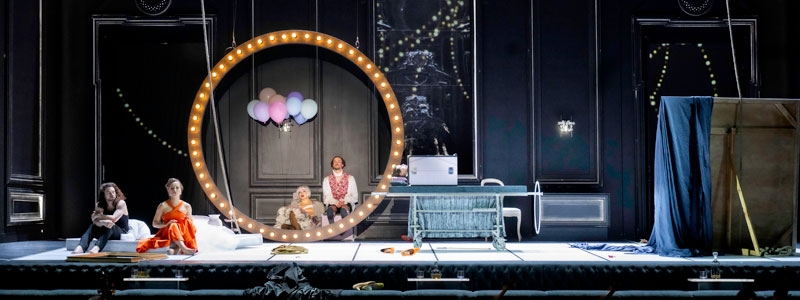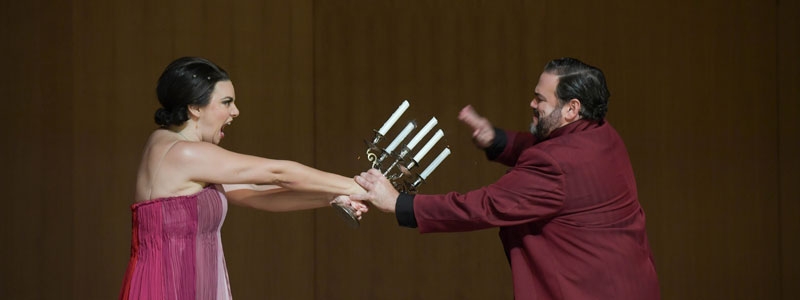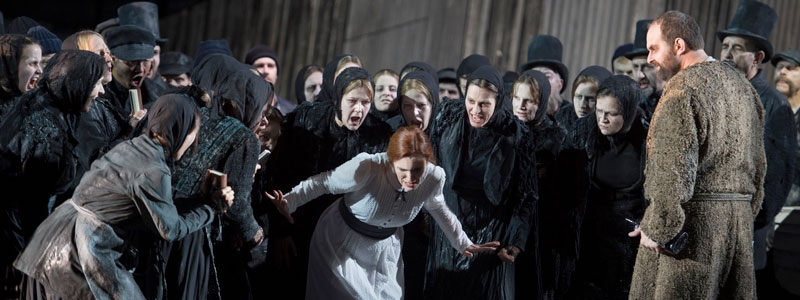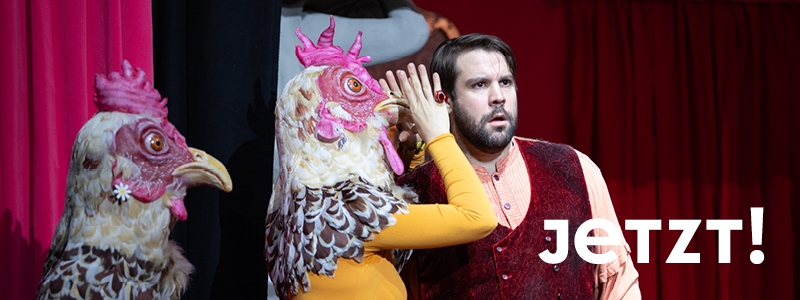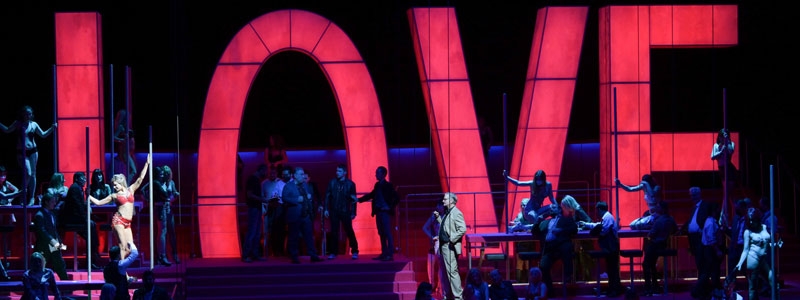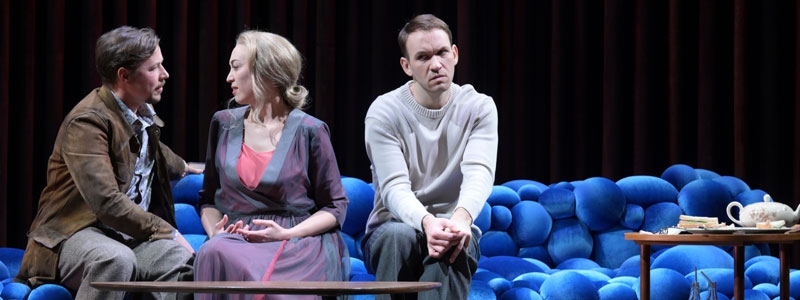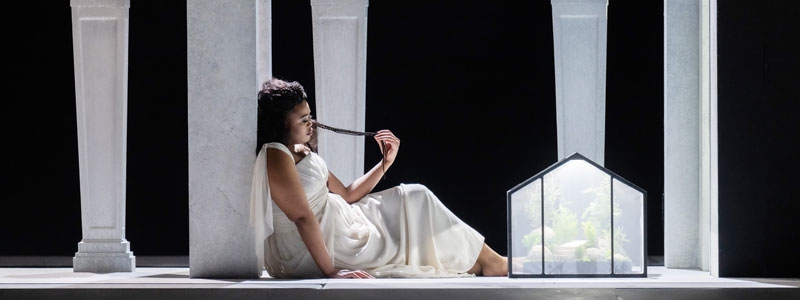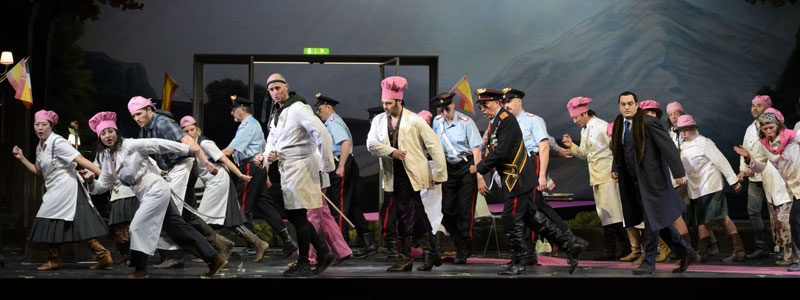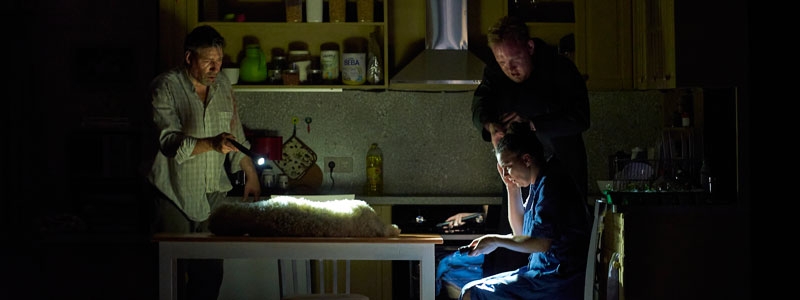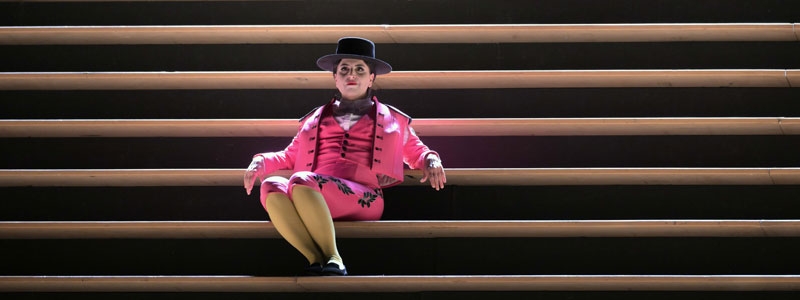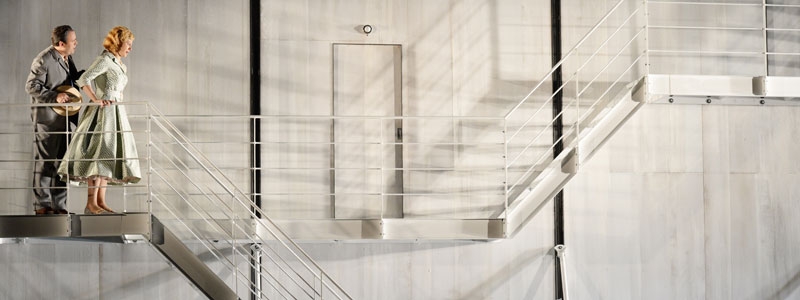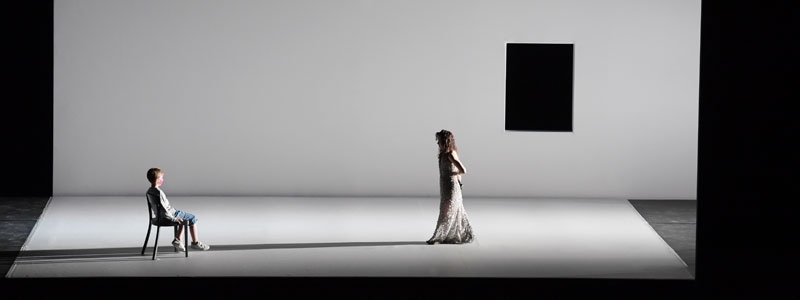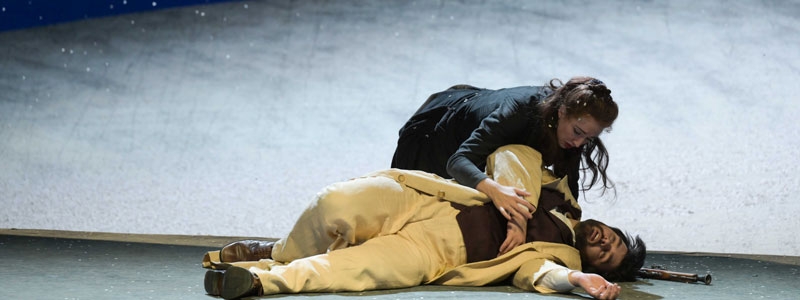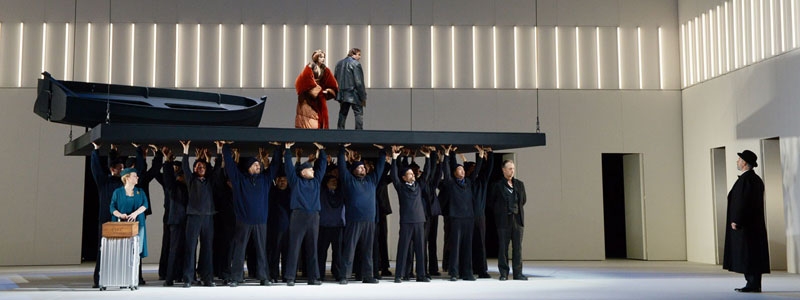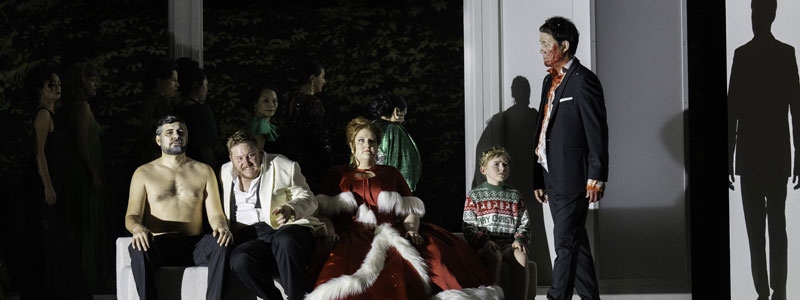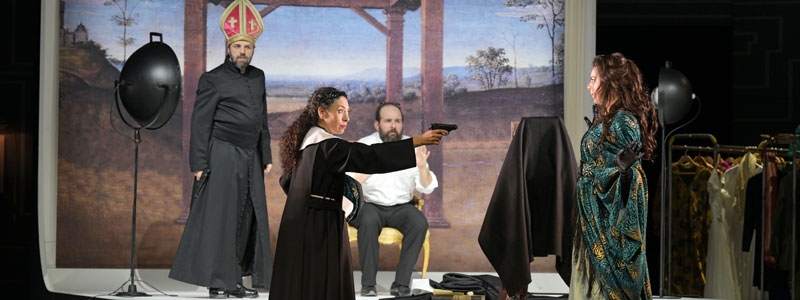Why must the Städtischen Bühnen be rebuilt? Most of the building on Willy-Brandt-Platz was built in the1960s. After roughly 70 it is mostly the in-house equipment and systems that need replacing. Faults frequently occur which disrupt the artistic side of things long term. Further adaptations and convertions are necessary to meet current legal requirements – such as workplace guidelines, fire safety measures, the orchestra rehearsal room being too small and workplaces and rest areas without natural light. The Städtische Bühnen must be completely renewed to guarantee the safety of the nearly 1200 people who work there.
What will happen if nothing is done?
Most of the in-house equipment is more than 30 years old. The older it gets the more likely there are to be faults and, even now, pieces that might need replacing are no longer available. Things including ventilation systems have already failed. Every year that passes without „doing anything“ increases the danger that other systems will fail and the ability to perform is restricted even further. If essential technical systems (in the areas open to the public, auditorium, stage itself) fail it would no longer possible to perform and the company would have to partially, or completely close.
How long are the theatres on Willy-Brandt-Platz allowed to go on working?
There is no set limit at the moment. Although the danger already esists that, as has already happened, technical systems fail and no replacement parts are to be had and new systems cannot be installed because of lack of space.
The specialist team and their work Who set the specialist team for the »Future of the Städtischen Bühnen« up? Town councillors instructed the municipal authorities to examine the building on Willy-Brandt-Platz, with a view to renovations, in the spring of 2018: Commissioned jointly by the CDU, SPD and Die GRÜNEN in the Römer NR 539 of 16.03.2018 – „Renovating or rebuilding the Städtischen Bühnen Frankfurt (SBF)“: here A meeting of town councillors commissioned: here Minister for Culture Dr. Ina Hartwig to set up a specialised team for the „Future of the Städtischen Bühnen“ led by the architect Michael Guntersdorf. Lord Mayor Peter Feldmann asked the heads of all departments in the city of Frankfurt to lend their support to the newly appointed specialist team. This team began working in the autumn of 2018.
Doing what?
To find answers to whether:
1 a structural refurbishment with maximum preservation of the existing building waspossible and economical?
2 could departments be outsourced?
3 would renovating the existing building reduce costs?
Independent specialised experts were engaged to examine possiblities. Including the planning team who did a stock take for the 2017 feasibility study. This comprised of an architect firm with long term experience of building and renovating theatres, an experienced engineering company, experts for in-house systems, fire safety evaluations, weight-bearing machinery, logistics and organisation.
What were the results? Two renovation possibilities were investigated:
I. BASIC Renovation: The structure of the building would remain, the most necessary things renovated and modernised. The entire investion involved was estimated at c. €826 Millionen (most of this going to pay for renewing in-house systems). Due to unresolved deficiencies in the building's structure no improvements in operation were possible. While work was being carried out both theatres would have to move into interim premises, which would be extremely expensive. This variation, because most of the defects in the building would still not be put right, despite the high costs, is not viable, economical or sustainable.
II. IMPROVED Renovation: Would make it possible to improve operational processes to a limited extent, e.g. by improving loading/unloading scenery. The opening up of the building would be partly realisable so that parts of it could be used by the public outside the season. The total investment costs for this were estimated at c. €918 million. Disadvantage: Very expensive with only relatively minor improvements. It's still an old building with structural deficiencies. Significant improvements to artistic conditions are not possible in this variation either, and, an interim solution would still have to be found for both companies. This variation is not viable, economical or sustainable either. As both renovation options yielded totally unsatisfactory results (costs do not bear any reasonable relation to results), two new construction options were examined as a next step: Building another double complex on Willy-Brandt-Platz. Would require an estimated investion of c. €874 Millionen. A new design could also help by upgrading Willy-Brandt-Platz as an urban area. Building a new theatre on Willy-Brandt-Platz and the other one somewhere else in the centre of town. Estimated investion: c. €809 Millionen. The costs are lower because only one interim venue would have to be found and paid for instead ot two.
How are these sums accounted for?
The respective total costs include not only investment costs for planning and construction measures but the costs of interim venues, appropriate risk surcharges, current estimated construction price increases during the project term, and costs for a new production centre too.
How can this project be financed?
Now that the city councillors have reached a decision, possibilities for financing it can now be explored. Several models are conceivable. The City of Frankfurt will try and find support and financial investment from the Land of Hessen and the Bundesrepublik Germany.
Have reports about investigations into renovating the theatres been published?
The following reports are available: a summary of the 2017 feasiblity study, the Specialist Team's report on the „Future of the Städtischen Bühnen“, which summarises investigations into renovations, planning reports and reports about interim venues, production centre and the costs involved: here
How do the 2019 investigation into renovating the theatre and the 2017 feasibility studies differ?
The specialist team's 2019 investigation into renovation was based on the 2017 feasiblity study. They were asked to check whether a renovation retaining as much of the existing building as possible was possible and economical. In this context it was also checked whether outsourcing departments in the theatre might create enough space for necessary building technology and meeting legal requirements. It was important to note that, in contrast to the feasibility study, no additional departments could be accommodated at Willy-Brandt-Platz or planned within the existing building. The latest investigation was made on the assumption that the building would be completely vacated for renovation or construction of a new double theatre complex without interruption or interim use. Political decisions Who will decide the future of the Städtischen Bühnen and what will be built?
The Städtische Bühnen Frankfurt is one of the largest municipal theatre and opera venues and is solely owned by the City of Frankfurt am Main. For this reason the city council, the supreme decision-making body in the city, also decides the future of the municipal stages. Dr. Ina Hartwig, head of the Department of Culture responsible for this, presented the city councillors with a basis for decision-making, which was supported in terms of content by the work of staff from the Städtische Bühnen.
What conclusions can the head of the department of culture draw from the specialist team's results?
Because of the clear results of these investigations Dr. Ina Hartwig recommended building new theatres instead of trying to renovate the existing building. None of the renovation options could remedy the existing serious functional deficiencies in the building complex, and at least 80% of the building's fabric would have to be rebuilt. For example barrier-free access cannot be achieved, occupational health and safety requirements cannot be met and delivery can only be improved to a rudimentary extent; opening up the building for urban use would only be possible to a very limited extent. Artistic improvements would be minimal. Only two new theatres would result in optimised buildings that meet the state of the art and guarantee sustainable, efficient and economical operation. It is irrelevant whether the theatres will perform in one or two new buildings in the future. The head of the Department of Culture also wanted at least one venue to remain onWilly-Brandt-Platz, the place where the cultural heart of the city beats. What have the city councillors decided?
At the city council meeting on 30 January 2020, city councillors decided (linked to the resolution and the PM supplement), on the basis of in-depth investigations by the specialist team, not to pursue the idea of refurbishing the existing building any longer and concurred with the Department of Culture, Dr. Ina Hartwig's recommendation. The cost of refurbishment was not significantly lower than for new buildings, would engender significantly higher construction risk, construction time and the need for both theatres to find interim venues for an estimated five to six years.
What happens now?
How is the specialist team looking into the »Future of the Städtischen Bühnen« now? They are investigating possibilities of finding central, city centre places for new theatres for opera and drama, or a double complex. The following variations are being looked into:
• Building a new opera house on Willy-Brandt-Platz with a theatre on part of the green belt opposite
• New opera house at Neue Mainzer Straße 47-51 and new theatre on Willy-Brandt-Platz
• New theatre at Opernplatz 2, opposite the Alte Oper, and new opera house on Willy-Brandt-Platz
• New double complex on Willy-Brandt-Platz
• A search is currently underway for somewhere to move both theatres to
On the basis of these investigations architects developed initial ideas, which would also improve urban spaces: Willy-Brandt-Platz could become more accessible and be used by the public in a more diverse way. The culture on offer at the Museum of Modern Art (MMK Tower) and the World Culture Museum would be placed in a new, larger context, and the green spaces could be given a connecting function as a "cultural mile" between the Jewish Museum and the Alte Oper. In the eyes of the head of the cultural department, the construction of a theatre on Willy-Brandt-Platz and the opera house next to Neue Mainzer Strasse is a particularly promising solution. Not least because it saves finding an expensive and complex interim solution for the opera. This option is also promising because it expands the embankment as a cultural mile and opens up new perspectives for the development of the city centre as a whole, Images of sketches and an overview of the cultural mile are available: here In the next step, requirements for both theatres will be defined. Questions of sustainable opera and drama houses, spatial and functional, as well as economic and urban development aspects will be examined, e.g. opening up to and radiating into the adjacent urban space, use for the public outside performance times, stage forms, stage technology, operating procedures, etc. Will there be an architectural competition? Recent visualisations are just ideas and will not replace the planned architectural competition.
Wouldn't two seperate theatres engender greater expenditure?
Operating costs of the new buildings would be favourable because they would meet latest standards, use up to date technology and efficient use of space. As things are, many essential and necessary departments (inc. lighting, sound, make-up, cloakrooms) are already independent in the opera house and theatre.
How many locations will the new theatres need? What are the transport logistics?
The Städtische Bühnen are already spread over seven locations in Frankfurt. The double theatre complex at Willy-Brandt-Platz is supplemented by two rehearsal stages (for opera and drama), three storage locations and the Bockenheimer Depot. The aim is to reduce the number of locations as much as possible. The Bockenheimer Depot will still be a performing venue. In an ideal world the rehearsals stages that are currently in other, rented, locations in the city, could either be situated in the new buildings or a joint production centre. Building a production centre would make it possible to unite the external warehouses that are scattered throughout the city and, if necessary, other departments, workshops and external rehearsal stages.
Will the Bockenheimer Depot still be a performing venue?
No changes in use of the Bockenheimer Depot are planned. It is possible that this venue could be used if an interim venue is necessary. This is being looked into.
What other possibilities are there for other interim performing venues?
This question can only be answered after a decision has been taken about what happens next. Several options were looked into by the specialist team. Renting venues and constucting temporary theatres were also examined.
Protection of monuments and the Wolken (clouds) Is the house on Willy-Brand-Platz a protected monument?
No. The municipal office of monuments and the state office of monuments have been dealing with the question of the building complex of opera and theatre since 2013. The present complex on Willy-Brandt-Platz only appears to be one building, whereas it is a complicated group of buildings which were built next to each other and on top of one another over a period of more that 100 years, parts of which have often been adapted or rebuilt. The building still contains parts of the original theatre from 1902. The large operatic stage and tower from the 1950s are still integrated in the complex, whose appearance has influenced its surroundings since the 1960s. A comprehensive inventory also showed that - as in other theatres and opera houses - parts of buildings were repeatedly adapted to the requirements of operations, fire safety measures and workplace regulations. Otto Apel's 1960s design has changed accordingly. The entrances, which were last changed in the early 1990s, the reconstruction of the opera house after the great fire in 1987, the reconstruction of the theatre's foyer and auditorium, extensive additions to workshops, ballet room and technical equipment on the roof are the most visible changes during recent decades. What's going to happen to the Wolkenfoyer?
The 120m long, 9m tall glassfronted foyer unites opera and theatre. The architekt Otto Apel's design for the transparant facade was in keeping with the current „International Style“. The foyer was enhanced with by golden clouds, designed by the Hungarian artist Zoltán Kemény, which can still be seen today. In the original foyer, the stairs in the theatre acted as a backdrop to the urban space. In the late 1980s both foyer and auditorium were rebuilt to comply with fire protection regulations. The effect is completely different today, the openness to urban space reduced. The symbol of openness and transparency created by the foyer on the first floor was quite unusual for theatres in the 1960s. So unusual that, at first, a curtain protected theatregoers from view from outside. The set-back entrance floor with its low entrance and predominantly closed form is clearly closed off from urban areas, so the building initially promises openness only through the upper glass box. The open character of the foyer and the effect of the gold clouds could also be sensibly reflected and further developed in a new building. The idea that the foyer with its fully glazed façade actually opens up urban space and can be walked through or invites visitors to stay, in a contemporary continuation of the democratic gesture, so to speak, should be retained. Opening the foyer outside event times is not possible in the existing structure: the foyer gives direct access to the auditoriums and back stage. The theatre therefore only functions when there are performances. The idea of opening up the stages to everyone is therefore not feasible in the existing structure. Especially today it is desirable that cultural buildings are accessible to society and can be used by everyone - not only audiences. Only in this way will they become the public places and cultural spaces in the city that are needed and desired by many.


